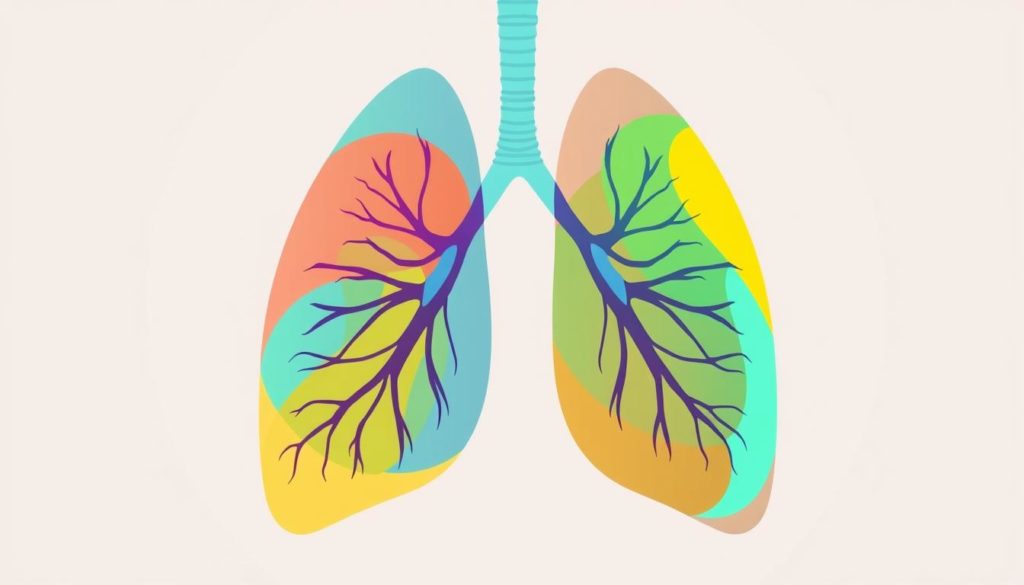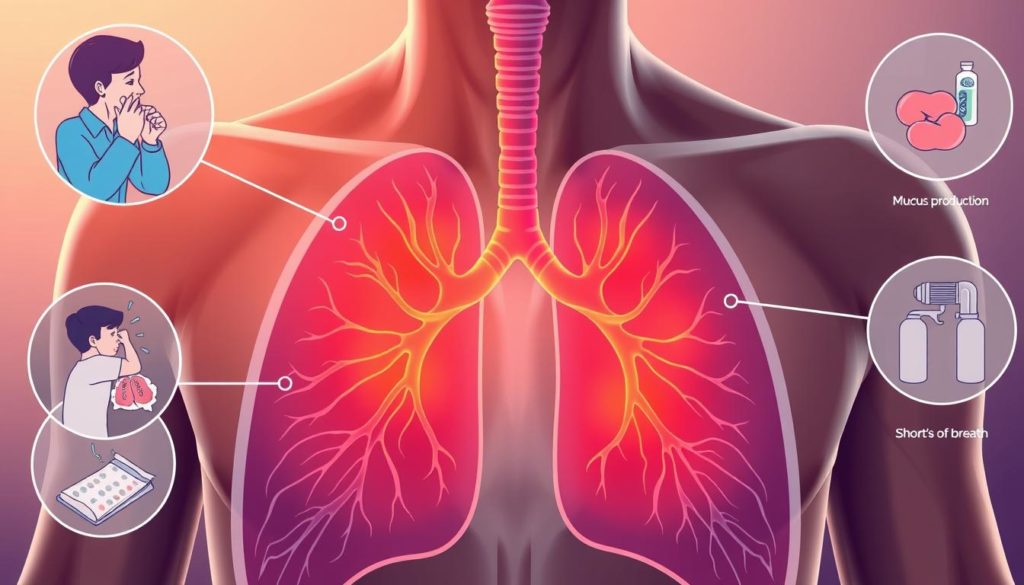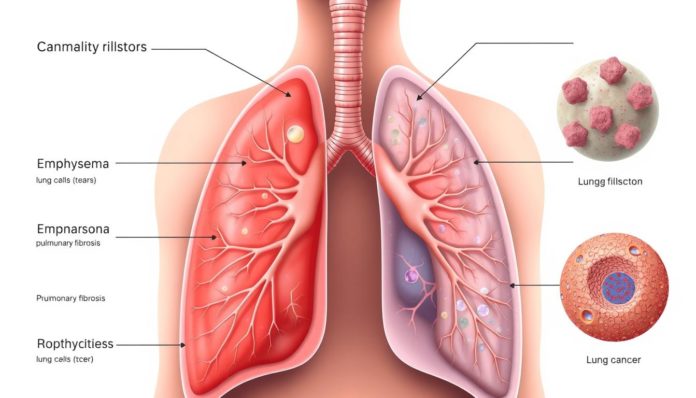Did you know nearly 40% of lung cancer patients get a wrong first diagnosis? This shows how crucial accurate diagnosis is for lung cancer.
Often, lung cancer doesn’t show symptoms early on. So, it’s key to tell it apart from other lung problems. Symptoms like persistent coughs, chest pain, breathlessness, and losing weight without trying are common in other lung diseases too.
Lungs don’t have many nerve endings. Because of this, these symptoms might not be noticed until cancer spreads. People at high risk, like smokers or those around asbestos and radon, should watch for any changes in their breathing health.
Knowing these details helps greatly with catching lung cancer early. This can make a big difference in treatment.
Understanding the Overlapping Symptoms
Many lung problems can look similar to lung cancer, leading to wrong diagnoses. Knowing these similar symptoms is essential for the right diagnosis and treatment.

Illnesses like bronchitis, pneumonia, and bronchiolitis, as well as allergies, asthma, and COVID-19, share symptoms with lung cancer. Symptoms include coughing, chest pain, and feeling short of breath. It’s hard for patients to tell these apart from lung cancer because of these shared symptoms.
To get a correct diagnosis, it’s important to notice the small differences and when these symptoms happen. For instance, unusual and ongoing coughing or breathing problems need checking to rule out lung cancer. Being aware and getting medical advice quickly helps manage lung health well.
- Coughing
- Chest Pain
- Shortness of Breath
Knowing these common symptoms and their overlap helps people speak up in medical settings. This ensures symptoms of lung cancer don’t get missed.
Bronchitis vs. Lung Cancer: Symptoms and Diagnosis
Bronchitis and lung cancer both cause similar symptoms, like a persistent cough. However, they are different in important ways. Understanding these differences is key to getting the right treatment.

Acute and Chronic Bronchitis
Acute bronchitis usually starts after a viral infection. Symptoms include coughing, mucus, and chest discomfort. It often gets better in a few weeks. In contrast, chronic bronchitis is long-term. It’s usually caused by smoking. Symptoms are a persistent cough and mucus. These last for at least three months, two years in a row. Chronic bronchitis can harm lung function over time.
Impact on Respiratory Health
Bronchitis affects your lungs, but lung cancer symptoms can be sneakier. Symptoms like a persistent cough, chest pain, and wheezing get worse slowly. Without treatment, lung cancer can have serious outcomes. It’s vital to catch lung cancer early. Often, symptoms aren’t enough to be sure. Doctors may need tests like imaging and biopsies to tell the difference between bronchitis and lung cancer.
Pneumonia vs. Lung Cancer: How to Tell the Difference
Telling pneumonia and lung cancer apart is tough since they share symptoms. Both can lead to chest pain, coughing, and fever. However, there are key distinctions that aid in telling them apart.
Infection-Caused Symptoms
Pneumonia stems from an infection that inflames the lungs. It brings chest pain, coughing, and fever, much like other lung infections. On the other hand, lung cancer might show weight loss and hoarseness. These signs are less common in pneumonia cases.
The Role of Diagnostic Tests
Diagnostic imaging is crucial for telling pneumonia and lung cancer apart. Chest X-rays and CT scans show the lungs’ state, revealing infections or tumors. Also, lab tests on lung fluids can pinpoint the infection type. Such advanced tests are key in differentiating these two serious health issues.
Asthma and Lung Cancer: Comparing Symptoms
Asthma is a long-term lung condition. It causes breathing problems due to swelling and narrowing of airways. Symptoms include cough, chest tightness, and wheezing. These are often set off by things like pollen or smoke.
Lung cancer shares some common symptoms with asthma, such as a constant cough and chest pain. But, lung cancer symptoms don’t improve by avoiding triggers. Spotting the key differences between them is very important for the right diagnosis and treatment.
Here is an overview of contrasting aspects between asthma and lung cancer symptoms:
| Aspect | Asthma | Lung Cancer |
|---|---|---|
| Symptom Triggers | Environmental factors (e.g., pollen, smoke) | Persistent, no clear triggers |
| Common Symptoms | Wheezing, chest tightness, cough | Persistent cough, chest pain, weight loss |
| Diagnosis Methods | Physical exams, medical history, spirometry | Imaging tests (e.g., X-ray, CT scan), biopsies |
| Treatment Approach | Inhalers, avoiding triggers, medication | Surgery, chemotherapy, radiation therapy |
To diagnose, doctors may use physical exams and imaging tests like chest X-rays or CT scans. Knowing these differences helps in treating asthma and lung cancer effectively.
Conditions That Mimic Lung Cancer
Many illnesses can be confused with lung cancer. These include pneumonia, asthma, COPD, acid reflux, and GERD. They have similar symptoms, so it’s very important to tell them apart correctly.
Benign lung tumors also make diagnosis harder. These non-cancerous masses may look like cancer, calling for advanced tests. Tumors in the chest’s center, called mediastinal tumors, pose a similar problem. Their symptoms can be just like lung cancer’s, highlighting the importance of careful checking.
Doctors often use imaging and biopsy tests to figure out the real issue. These steps help avoid wrong diagnoses. This way, doctors can understand the conditions that look like lung cancer better and find the right treatments.
- Imaging Tests
- Biopsies
- Thorough Medical History
Knowing these diagnosis challenges ensures patients receive accurate care. It shows how crucial a detailed and careful diagnosis is. It’s all about spotting the various conditions that resemble lung cancer and tackling each case with a full diagnostic plan.
The Impact of Chronic Obstructive Pulmonary Disease (COPD)
Living with COPD means dealing with symptoms similar to lung cancer. This makes diagnosing harder. Doctors must assess cases carefully.
Shared Symptoms
COPD and lung cancer share symptoms. You might see a persistent cough, shortness of breath, and wheezing. Because of this, both patients and doctors often explore multiple diagnoses.
Diagnostic Challenges
Identifying COPD vs. lung cancer takes detailed medical checks. Tests like X-rays or CT scans are used, along with lung function tests. Knowing the difference is key for the right treatment and better outcomes.
Lung Nodules: Benign vs. Malignant
It’s important to understand the difference between lung nodules for lung cancer detection. These small tissue masses can be non-cancerous or a sign of cancer. Knowing the difference between these types is crucial. It requires advanced imaging tests and careful diagnosis.
When lung nodules are spotted on a chest X-ray or CT scan, a biopsy may follow. During this, a tiny tissue sample is taken for closer examination. This method’s accuracy is key for deciding the right treatment.
Here’s how benign and malignant lung nodules compare:
| Types | Characteristics | Diagnostic Methods |
|---|---|---|
| Benign Tumors | Non-cancerous, typically not life-threatening | Chest X-rays, CT scans, biopsies |
| Malignant Nodules | Cancerous, potential spread to other organs | Chest X-rays, CT scans, PET scans, biopsies |
About 55% of benign lung tumors are hamartomas. Other types include bronchial adenomas and fibromas. Meanwhile, malignant ones may spread and need urgent treatment.
Getting lung nodules diagnosed accurately is essential. It requires advanced imaging and tests. Early and correct diagnosis greatly affects the treatment’s success and the patient’s health.
Heart Disease and Lung Cancer: Overlapping Signs
Heart disease and lung cancer are both grave conditions with similar warnings. These include hard breathing, chest pain, and feeling very tired. Knowing these common symptoms is key to telling the conditions apart for the right treatment.
Pulmonary Edema
Pulmonary edema means too much fluid in the lungs, causing breathing troubles. It’s seen in both heart and lung cancer issues, which might confuse doctors. Spotting pulmonary edema helps doctors figure out if it’s heart disease or lung cancer.
The Importance of Cardiovascular Evaluation
To correctly handle these overlapping signs, a thorough heart check is crucial. This check involves deep diagnostic imaging and tests to find what’s really causing the symptoms. By doing so, doctors can avoid wrong diagnoses, leading to better care for patients.
See the table below for what symptoms are shared and what are not:
| Symptoms | Heart Disease | Lung Cancer |
|---|---|---|
| Shortness of breath | ✔️ | ✔️ |
| Chest pain | ✔️ | ✔️ |
| Fatigue | ✔️ | ✔️ |
| Persistent cough | ❌ | ✔️ |
| Swelling in legs | ✔️ | ❌ |
| Unexplained weight loss | ❌ | ✔️ |
Allergies and Lung Cancer: Similar Respiratory Issues
Allergies sometimes look a lot like lung cancer. This can make it hard to know what’s wrong. Coughing, feeling a tight chest, and wheezing are common signs. These symptoms can make people worry.
Allergies trigger a histamine response. Histamines play a big role in how we react. They can lead to trouble with our lungs and breathing. This makes some wonder if they have allergies or something more serious.
Doctors use medical histories and tests to tell the difference. It’s important to get the right diagnosis. Mistakes can be dangerous when it comes to breathing problems.
Both allergies and lung cancer share signs:
- Cough
- Chest tightness
- Wheezing
Knowing the difference between their symptoms is key. Always check with a doctor for the right treatment. It’s crucial, especially to catch serious issues like lung cancer early.
COVID-19 and Lung Cancer: Diagnostic Challenges
COVID-19 and lung cancer share symptoms, which complicates their diagnosis. Both can make breathing hard. It’s vital to accurately tell them apart to treat patients right.
Respiratory Overlaps
COVID-19 and lung cancer both might cause a lasting dry cough and breathlessness. These similar signs often lead to wrong diagnoses initially. Careful assessment is necessary.
The virus causing COVID-19 attacks the lungs, showing symptoms similar to lung cancer. Because of this, doctors need to be thorough and precise in diagnosing.
Importance of Accurate Testing
Distinguishing COVID-19 from lung cancer requires reliable tests. COVID-19 is confirmed through PCR tests for its genetic material. Meanwhile, lung cancer needs imaging and biopsies to spot cancer cells.
Using different tests helps doctors tell these conditions apart:
| Diagnostic Method | COVID-19 | Lung Cancer |
|---|---|---|
| PCR Testing | Identifies SARS-CoV-2 | Not Applicable |
| CT Imaging | Shows lung involvement | Detects tumors |
| Biopsy | Not Applicable | Confirms malignancy |
Cystic Lung Diseases and Lung Cancer: Finding the Differences
Cystic lung diseases often get confused with lung cancer. They share symptoms like persistent coughing and trouble breathing. Understanding these shared signs is key. It helps correctly identify lung cancer. This ensures patients get the right treatment.
Common Symptoms
Both cystic lung diseases and lung cancer share symptoms. This makes telling them apart hard. Symptoms of CLD include:
- Chronic cough
- Shortness of breath
- Chest pain or tightness
The similarity in symptoms highlights the need for accurate diagnosis methods.
Diagnostic Approaches
To tell cystic lung diseases from lung cancer, doctors use advanced tools. They use high-resolution CT scans and genetic tests to find cysts or gene changes. Understanding a patient’s history and how symptoms change is also crucial. This approach is vital for accurate lung cancer identification.
| Diagnostic Method | Purpose |
|---|---|
| High-resolution CT Scan | Identifies cystic structures in the lungs |
| Genetic Testing | Detects gene mutations related to cystic lung diseases |
| Biopsy | Confirms the presence of malignant cells |
The Need for Accurate Diagnosis and the Role of Biopsies
It’s vital to diagnose lung cancer accurately and early. An early diagnosis can mean a better chance at beating the cancer. Sometimes, symptoms look like lung cancer but are from other issues like bronchitis or pneumonia. That’s why being precise in diagnosis is so important. Biopsies are key in this process.
A lung cancer biopsy involves taking small pieces of tissue to check for cancer. This can be done with a needle or through surgery. By doing this, doctors can tell if a lung spot is cancerous or not. This step is crucial, as it helps decide the right treatment for each patient.
The timing of a biopsy is also critical. Catching cancer early through accurate diagnosis can lead to starting treatment sooner. This can greatly improve a patient’s outlook. As the medical field grows, the need for biopsies in detecting lung cancer stays central. Quick and accurate diagnosis leads to early treatment and better chances for the patient.
FAQ
What kind of pulmonary diseases can be mistaken for lung cancer?
Diseases like bronchitis, pneumonia, and asthma can show the same symptoms as lung cancer. Symptoms include coughing, shortness of breath, and chest pain. Conditions like COPD and allergies can too.
How can one understand the overlapping symptoms between different pulmonary diseases and lung cancer?
Many pulmonary diseases share symptoms with lung cancer, like coughing and chest pain. Lung cancer might also cause unexplained weight loss and a hoarse voice. It’s crucial to see a healthcare provider for a correct diagnosis.
What are the key differences between bronchitis and lung cancer?
Acute bronchitis is often from a viral infection and gets better quickly. Chronic bronchitis lasts longer. Both can have cough and chest pain like lung cancer. But, lung cancer also often includes unexplained weight loss and continuous symptoms.
How do symptoms of pneumonia compare to those of lung cancer?
Pneumonia symptoms include chest pain, coughing, and fever. Lung cancer can have these symptoms too, but also adds unexplained weight loss and hoarseness. Tests like chest X-rays help tell them apart.
What symptoms do asthma and lung cancer share?
Asthma and lung cancer both can lead to coughing, chest tightness, and wheezing. Asthma symptoms can flare with triggers. Lung cancer symptoms can happen without clear reasons. Diagnosis needs thorough testing.
What conditions typically mimic lung cancer?
Conditions like benign lung tumors and COPD can seem like lung cancer. Cystic lung diseases and thoracic Hodgkin’s disease can too. They all share similar symptoms.
What is the impact of COPD on lung cancer diagnosis?
COPD and lung cancer both cause shortness of breath and a lasting cough. This makes diagnosis hard. Doctors use detailed exams and tests to tell them apart.
How can lung nodules be differentiated into benign or malignant?
Lung nodules are found with tests like X-rays. A biopsy is then done to see if they’re cancerous. This ensures correct treatment.
How are symptoms of heart disease and lung cancer similar?
Both conditions can make you feel short of breath and have chest pain. Tests for heart health and imaging are needed to tell them apart.
How can respiratory issues from allergies be differentiated from lung cancer symptoms?
Symptoms from allergies and lung cancer, like coughing and wheezing, can look alike. Allergy tests and medical history help doctors find the difference.
What are the challenges in differentiating COVID-19 and lung cancer symptoms?
COVID-19 and lung cancer both can cause a dry cough and trouble breathing. Getting the right tests is key for a correct diagnosis.
How can cystic lung diseases be mistaken for lung cancer?
Cystic lung diseases lead to breathing difficulty and coughing, similar to lung cancer. Special tests are needed for the right diagnosis.
Why is an accurate diagnosis crucial for lung cancer?
Correctly identifying lung cancer through tests is vital. It means starting the right treatment early. This can greatly improve recovery chances.


